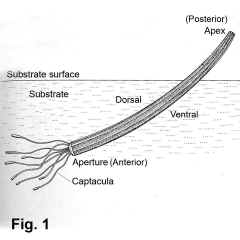|
< Previous family introduction |
|
|||||
|
Class Scaphopoda and Family Dentaliidae Tusk Shells
|
||||||
Fig. 1: A scaphopod in life position in the sediment, showing captacula. (After The Southern Synthesis, Fig. 10.1) |
Class Scaphopoda The scaphopods (tusk shells) constitute a separate class of the Mollusca, although small in number, with a unique shell and animal structure. Scaphopods have a tubular shell open at both ends, which the animal creates and within which it resides permanently. The head, foot and feeding organs are at the wide end, buried in the substrate when alive, while the narrow end is, at least intermittently, raised above the substrate for waste and gamete release. There are two orders within the class Scaphopoda. In the order Dentaliida the shells are large and often longitudinally ridged, the foot-tip is conical, and the form of the radula is characteristic. There are four families in this order occurring in NSW. In the other order, Gadilida, the shells are small or very small and usually smooth, the foot is worm-like, and the radula is different to that of the Dentaliida. There are three families of this order in NSW. Scaphopods mainly occur in water deeper than 50 metres, although a few species have the uppermost extent of their depth distribution in the lowest intertidal zone. Many occur in the abyssal zone (below 2000 metres); Siphonodentalium galatheae is recorded from 7000 metres depth. Scaphopods are sedentary animals, mostly living in the top few centimetres of the substrate. They live in a variety of sediments ranging from coarse gravel or coral rubble to clean or muddy sand or clayey mud. When alive, the shell is oriented at 30–40 degrees to the substrate surface (Fig. 1). For feeding, scaphopods are equipped with fine, thread-like organs on the head called captacula (Fig. 1), varying in number from 30 to about 300, which are used to locate minute prey in the substrate. Prey includes foraminiferans, bivalve spat, ostracods and diatoms. Once the foot has excavated a cavity in the substrate, the captacula locate and take hold of the prey and move it to the mouth, where it is consumed. Scaphopods occur worldwide; the world population is estimated at 500–600 species. In Australia, 108 species were documented by Lamprell & Healy (1998), of which 36 species are listed as occurring in NSW waters. No additional species have been recorded from NSW since Lamprell & Healy (1998). The Australian fauna includes wide-ranging species that occur in the Indian, Southern and Pacific Oceans, as well as species known only from a few specimens from a small area in NSW. It is unclear whether this is due to limited deep-sea sampling or whether there are actually endemic species with restricted distributions.
Family Dentaliidae The shells of the Dentaliidae are robust and longitudinally ribbed, at least near the apex, in contrast to shell of the other scaphopod families which are generally small and smooth. Family reference Lamprell, K.L. & Healy, J.M. 1998. A revision of the Scaphopoda from Australian waters (Mollusca). Records of the Australian Museum Supplement 24: 1–189. Coverage All the named species of Dentaliidae that occur in NSW waters are treated here. Identification notes The narrow end of the shell is the apex, the wide end is the aperture (Fig. 1). |
